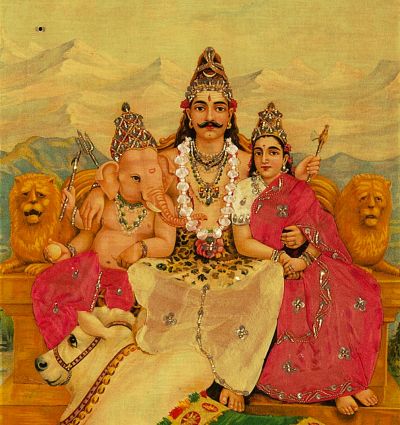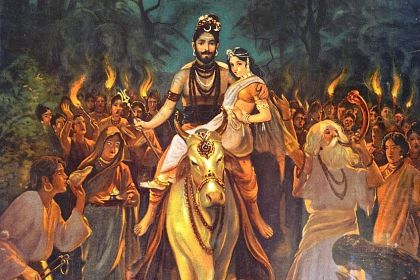MEDITATION
Om Namah Shivaya: chant meaning and lyrics diversity in songs set in Panchakshari Mantra

The Holy Family by Raja Ravi Varma
Om Namah Shivaya mantra has been an essential chant in Hinduism for over three thousand years. It is meant to express adoration to Shiva—one of the most revered Hindu deities in possession of at least 1008 names, each characterizing a particular form or avatar assumed by Shiva.
The chant begins with the most sacred syllable symbol Om—the initial sound from which the vibration that generates the perceived universe has started. Following the Om, the five-syllable mantra Panchakshara is chanted to praise the universal oneness of Shiva and the five elements Na Ma Śi Vā Ya, representing earth, water, fire, Pranic air, and sky respectively. However, the interpretation of each syllable may differ depending on the traditions of Shaivism or a specific region.
Traditionally, Om Namah Shivaya should be chanted verbally or mentally 108 times a day while recounting the special rosary made from the rudraksha seeds. Rudraksha is a Sanskrit compound word consisting of Rudra—one of the oldest names of Shiva traceable to the Vedic literature of the 2nd millennium BCE—and akṣa meaning teardrops. Om Namah Shivaya is generally accepted to be a powerful healing mantra beneficial for all physical and mental ailments, the recitation of which can calm the mind and bring spiritual insight.
To make chants based on Panchakshara mantra more euphonic and convenient to sing, their lyrics are often supplemented with other texts related to Shiva. So in one of the most common stanzas, a semblance of the refrain Har Har Bhole is added, in which Har, meaning 'everyone,' represents every devotee, and Bhole, derived from Bholenath, invokes one of the names of Shiva meaning 'a Lord of simple people'.
Aum Namah Shivaya
Aum Namah Shivaya
Har Har Bhole Namah Shivaya
Musically, the mantra is often set to one of the classic ragas of Hindustani tradition with preference given to the Malkauns raag which, according to some sources, was composed to tame Shiva's dance. In southern India, songs rooted in Panchakshara mantra are mainly sung to melodies originating in the Carnatic scales of Mēḷakarta.
Listen to Om Namah Shivay set to Raag Malkauns performed by Sanjeev Abhyankar:
When Om Namah Shivaya is performed outside India, the music harmony primarily follows the canons of Western classical music as vividly demonstrated in the version composed by the American artist Krishna Das using the key of C minor.
Listen to Om Namah Shivaya performed by Krishna Das:
Here, the lyrics of Panchakshara mantra also include the following spiritual names:
- Arunachala: refers to Annamalai hill in Tiruvannamalai, the location of a principal Shiva temple
- Girijaa: one of the many names of Goddess Parvati married to Shiva
- Shambho: an auspicious and gentle form of Shiva
- Shankara: an Indian philosopher and theologian who is credited with unifying the main currents of thought in Hinduism.



